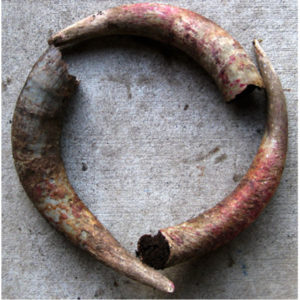Growth Regulating Hormonal Plant Sprays
By Dennis Klocek 26 min read
Science recognizes two fundamental and antagonistic hormones that act as plant growth regulators: cytokinin and auxin. There are of course other hormones active in plants along with many hormone precursors but these two can serve as useful examples for understanding the development of a rational system of plant sprays that can be fermented from natural substances. These ferments can take the place of the synthetic chemicals currently mainly used in the food industry on fruits as well as on other crops.
Hormones regulate axial and lateral growth
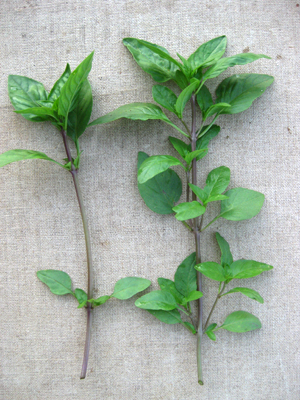
Cytokinin induces in plants what could be called axial or spreading growth. That is growth that takes place in the horizontal direction. Spreading growth favors vegetation as a result of short internodes. This gives bushy shapes to plants as seen on the right.
Auxin by contrast induces what in plants is known as apical dominance or stemming growth. This is growth that takes place vertically in the plant. It produces a plant gesture of slender, upright growth with long internodes as seen on the left.
The alternation of stemming and spreading gestures in the growth of an annual plant is relative to the alternation of these two hormones as the plant goes from germination, through growth and into flowering and seed set. A summary of the two alternating hormones is instructive of how sprays made from ferments can be created and employed to control plant growth.
These alternating effects can be seen in:
A germinating seed:
- Cytokinin stimulates the emergence of the radicle.
- Auxin stimulates the emergence of lateral roots in the pericycle and the development of the plumule.
The plant meristem:
- Cytokinin stimulates cell proliferation laterally with little form.
- Auxin stimulates the longitudinal stretching of the cells that have proliferated and gives them form.
Early seedling development:
- Cytokinin stimulates early xylem formation.
- Auxin stimulates the early formation of phloem.
Young shoot growth:
- Cytokinin transfer upwards in the plant through the xylem in the center of the plant.
- Auxin transfers downwards through the phloem to retard axial bud shooting.
Greenwood shoot growth on mature stems:
- Cytokinin activity pushes axial buds out of the leaf axils along the shoot.
- Auxin maintains apical dominance of the terminal buds to keep the shoot stretching the internodes.
Before bud break:
- Cytokinin promotes multiple inflorescences in growing plants (see terpene wort).
During fruit set:
- Auxin elongates the anthers and extends the pollen tube in the stigma during flowering (see pollen wort).
During fruit swell:
- Cytokinin governs the swelling of the fruit in the context of available potassium (see fruit wort).
Creating hormone-based ferments
The sequences of these hormonal influences can be used as templates for creating ferments using embryos and flowers to regulate plant growth through foliar applications of sprays. The ferments have three components: an essential oil source from hydrosols, a hormone source and enzymes that provide an energy source. The essential oil hydrosols are steam-distilled from medicinal herbs. These herbs provide a palette of essential oil fractions that are widespread in plant growth. These oils are selected to promote and regulate cell division in the meristem. The oils do this by serving as precursors and ‘signalling compounds’ in the formation of hormonal plant growth regulators.
The hormone sources in the sprays come from germinating seed embryos and pollen-producing flowers. These substances provide the plant with signals that stimulate it to grow in particular ways. The choice of particular sources for the hormones allows for various recipes to be developed to take advantage of specific growth periods in the sprayed plants. The energy sources allow the oils and hormones to be harmonized and digested. These are provided by malted grains and natural fruit sugars from ripening fruits with amendments like dextrose or molasses added for specific ferments. These sources provide enzymes along with the sugars to activate the digestive nature of the ferments and control the degree of digestive power in the yeasts. This kind of control is useful in preserving the integrity of the oils and plant growth regulators in the fermenting process.
The below oils share many fractions in common. This means that they have strong affinities for each other in compounds. The affinities create synergistic effects that enhance the power of the individual oils. For instance, geraniol when fractionated into its components proves to be exceptionally high in citronellol. Citronellol from citrus sources when fractionated is high in geraniol and linool. The two are mirroring each other.
- Helichrysum italicum – cedrene 14% (cedar)
- Cucurmene 12% (turmeric)
- Geraniol 10% (pelargonium)
- Limonene 6% (lemon)
- Nerol 5% (bitter orange)
- Pinene 4% (pine)
- Linaool 3% (lavender)
- Pelargonium graveolens – high citronellol 37% (citrus) and geraniol 33% (pelargonium)
- Linalool 18% (lavender)
- Menthone 9% (mint)
- Melissa officinalis – high geraniol 40% (pelargonium) and nerol 30% (bitter orange)
- Caryophyllene 20% (caraway/pepper)
- Citronellol 6% (citrus)
- Sweet Basil – high eugenol 31% (clove oil) and linalool 29% (lavender)
- Chavicol 27% (tarragon)
Helichrysum and Pelargonium
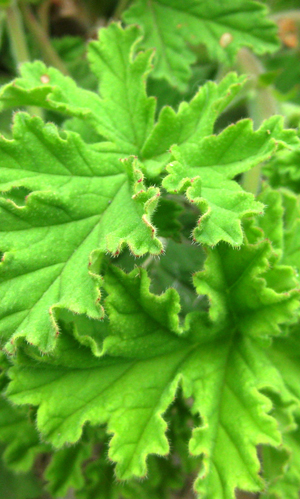
Pelargonium and helichrysum are standard sources In the hydrosol mixes used as a vehicle for the ferments. Both have a profound influence on cell division. They are chosen for the sprays because the target for all of the sprays is the cell division rhythms of the plant meristems.
These oils also have many smaller percentages of oils or even trace fractions of more complex substances in them as well as the major terpenes cited above. Often it is the smaller fractions of more complex substances in the hydrosols that effectively bridge the gap between the oil-soluble terpenes and the water-soluble phenolics.
Substances that make these kinds of chemical bridges are most often active as precursors or signal molecules for active chemistry within plants. The precursors are most often involved in hormonal production as signal substances during critical times in plant development such as germination or flowering. As a result, the synergistic mirroring of helichrysum italicum and pelargonium is sought as a stimulus for hormonal precursor activity in the ferments.
The bridging between the terpene fractions or even the bridging between terpenes as oil-soluble and phenolics as water-soluble elements is common in the most potent medicinal properties. For instance, cannabinoids found in the cannabis family are examples of phenol-terpenoids. They are produced by a highly complex series of several precursors that unite oil-soluble terpenes with water soluble phenolics.
This kind of bridging is characteristic of the most active precursors. The goal of the sprays is to provide a palette for the growing plant in order that synthesis of the precursors can more easily be accomplished in the growth process.
Grape must and brewer’s wort
The hormonal constituents serve to guide a sprayed plant with natural hormone sources at specific stages of growth. The basis for the most fundamental spray is the use of organisms to create ferment conditions that will produce hormones and enzymes to support the terpene and phenolic elements in the final spray.
To preserve these delicate substances requires the use of fermentation processes. A typical ferment process in use today is the production of alcohol through the ferment of juice from fruits and grains. Fruit fermentation from dicotyledon plants produces an alcohol that by nature is 12 to 15 percent alcohol by volume. The expressed juice of a grape known as must can serve as an example.
Sugars are formed in the berry that is ripening. The plant produces phenolic pigments and terpenes to protect the growing embryo in the seed. At maturity, a yeast forms a bloom on the skin of the grape based on the sugar content of the juice. When the juice is pressed the must has a particular specific gravity due to the density of the sugars. The sugars will then be acted on by the yeast on the skin of the grape.
In this highly enzymatic ferment, the pigments and terpenes in the grape juice are blended into complex forms as the yeasts convert the sugar to alcohol. Fruit left in the fermenting must is actively dissolved as the yeast invades all tissues while consuming the sugar. This is a clear oversimplification of a very complex process but in essence this is the action of a ferment involving sugar, enzymes and hormones.
In such a ferment, the yeast working at 12% potential alcohol can degrade and volatize many of the more delicate molecules in the must. To make useful hormone sprays this strong action is not advantageous. As a result the work with ferments in which the hormones and essential oils are not so volatized is based on the ferment of a wort rather than a must.
Brewers use the term wort for the yeast that converts sugary liquid mash into a 4 or 5% alcohol. This is in contrast to the 12% alcohol tolerance of wine yeast in the must. For this reason, beer brewers extract starches from grains that do not have such high sugar content. However, in order to use these weaker sugar sources it is necessary to bring the grains into a stage that allows the yeast to sustain a ferment. This is achieved through malting.
Malting grains
Seeds of monocotyledons like corn, barley and even coconut are provided with enzymes and hormones such as cytokinin that upon germination allow the seed to rapidly multiply the cells in its meristem. The enzymes in these seeds are used by brewers in the process of making beer wort. The enzymes convert the starch in the seed into sugar to feed the yeast that creates the alcohol. To do this the brewers malt the seed.
Malting involves germinating the corn or barley until a radicle comes out of the seed and a short shoot begins to appear. At that stage, the brewer stops the germination to preserve the diastatic potentials in the enzymes. Diastatic potential describes the enzymatic ability of the embryo to convert the starch or food in the endosperm into sugar. The diastatic potential differs in the different qualities of malted grains. This needs to be matched to the yeast that will make the ferment.
Yeast is highly sensitive to the different levels of alcohol in the ferment and the use of malts to support fermentation is an advanced science. The yeast for a beer ferment is known as wort. In barley malt, the germination process is stopped retaining the enzymatic capacities of the embryo. This by itself will support beer yeast.
However, the addition of hydrosols to the ferment creates a need for further sugars to be added. In this work of making the worts for plant sprays the additional sugars are provided by dextrose, barley malt extract and molasses. Dextrose is corn sugar and is employed when corn is the grain that is germinated for the malt. Barley malt extract is a sugar that is employed when barley malt is used. Molasses is a sugar from sugar cane and makes a good linkage to the use of the coconut water in the mix.
Blackstrap molasses is the least sweet sugar and is a source of many minerals that support the growth of the yeast. It is a good addition to most ferments but doesn’t bring a lot of sweetness for the yeast. It can be supported in a ferment with half the amount of honey in comparison to the blackstrap molasses. The honey also lends great enzymatic contributions to the wort.
Making the standard wort
The great advantage of using beer wort in making hormonal ferments is not only the gentle action of the yeast but the hormonal contribution of the diastatic malt to the overall effectiveness of the ferment. Grains that were stopped at the malt stage contain a large amount of cytokinin. The cytokinin in the wort is preserved by the strong enzymatic action of the malted grain. The gentleness of the wort creates a very aromatic blend with the essential oils of the hydrosols. The making of corn malt can serve as an example of the malting process.
Directions for making corn malt:
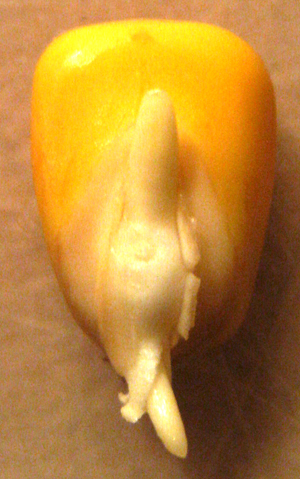
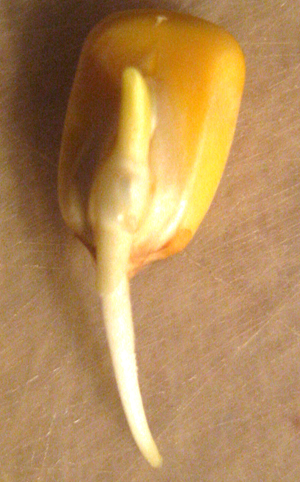
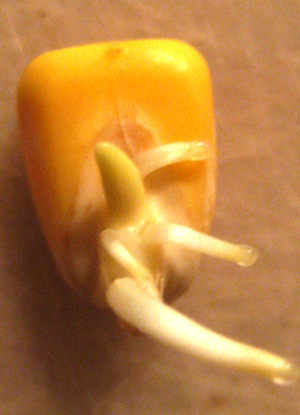
Soak a half-pound of dry corn for 24 hours. Then keep the kernels moist on a towel until they germinate (1) and form a radicle (2).
Wash them twice a day until lateral roots emerge (3). When lateral roots emerge the seeds are producing cytokinin.
Grind the seeds into a paste. Pour on water at 50°C/105°F. Let this soak for an hour. At the same time pour the hot water on a half-pound of cracked corn or coarse cornmeal and let that soak. This draws out the starches and the enzymes for digesting them along with the cytokinin. The product is now known as corn mash.
After soaking bring the mash to 65°C / 125°F and keep it there for another hour. This allows the enzymes to start digesting the starch and converting it into sugar.
After an hour strain the mix and pour in a quart of coconut water and some molasses or dextrose. Check the potential alcohol with a hydrometer and pour in the hydrosols to adjust the sugars to 4.5% potential alcohol. This is the standard wort liquid for fermenting.
A cap of chopped helichrysum, pelargonium, melissa and basil is floated on top. The wort yeast is added on top of the cap when the temperature drops down to 40°C.
This is the standard ferment from beer wort. Other herbal additions described below can steer the wort into specific crop needs.
Life gestures in plant growth
It is useful here to state a guiding principle in this work known as life gesture. The life gesture of a plant is a complex arrangement of the forms of the plant as it unfolds its growth. Most annual plants alternate between a horizontal gesture that characterizes the vegetative portion of the growth cycle and a vertical gesture that characterizes the same plant as it approaches flowering.
The stretching of the internode or stemming is governed by auxin and the spreading of the axial bud is governed by cytokinin. These two opposing gestures actually alternate in the life of a plant. When selecting a plant for use in a hormone and enzyme wort the extent of stemming and spreading is a useful tool for choosing the correct phase of growth that the spray for which the spray will be used. A clear example of life gesture can be found in the grapevine.
Grape berries and hormone production
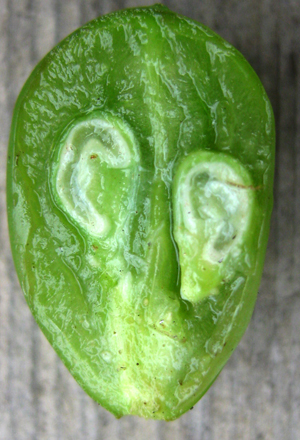
Early in the spring, in many varieties, before the vegetative buds open, if the vine is cut it bleeds copiously. The sap of the sugar maple or the grapevine at that time is rich in cytokinins. These hormones will be used by the tree or vine to create profound cellular growth.
In the grapevine, this hormone is the source of growth forces for the cane after the vegetative buds open. When the cytokinin is active in the sap, potassium and calcium are in full flow. Once the vegetative buds open the cytokinin is shunted into new fruiting cane development.
At that time, the old cane no longer bleeds when cut. At the formation of flower buds sixty days later, auxins begin to dampen down the excessive flow of cytokinin in the green cane and turn the accelerated growth into form-producing organs for flowers. At their bases, the green canes begin to become woody revealing the influence of auxin.
When the flower is fertilized and the fruit is set auxin production diminishes and the cytokinin that was moving in the cane is shifted into the grape embryos. This makes the immature grapes a rich source of cytokinin while the flowers are richer in auxins. As soon as the grape’s seeds begin to develop in the berry (above) another shift from cytokinin and its cell-proliferating forces occurs to the formative forces of auxin and its related hormones of gibberellic acid.
The jelly-like embryos begin to form sheaths around the embryos and as a result, the grape berry is now not a good source of cytokinin. The time period between the two phases is about a week. This means that certain times are better for creating some worts than others. In general, the spring is great for burgeoning growth and cytokinin sources in embryonic fruits and the fall is best for pollen formation and the form influences of auxin.
Of course, actual practices are much more complex than this scenario but it is illustrative of the potentials for tailoring specific worts for use that can best be done in a particular season and then best applied at another time. The following terpene wort, pollen wort, fruit wort, and leaf wort recipes are given to get an idea of how these ferments can be tailored to a particular plant organ development.
Terpene wort
Ingredients: corn malt, barley malt, coconut water, hydrosols, fresh chopped helichrysum, rosemary, lavender, pelargonium, basil, melissa, marjoram, young orange leaves, orange fruits and bay leaves.
The purpose of this ferment is to enhance the production of terpenes in medicinal plants. Terpenes are oil-soluble fractions and are often enhanced in a medicinal plant as a response to the forming of the anthers in the flowering process. In essence, the more inflorescences and the more anthers on a plant the more terpenes will be produced in its tissues.
This is because in many plants heavy flowering triggers the phytochemical induction process of the formation of essential oils. Spraying the terpene wort after flowering is counter-productive but spraying before the flowers form causes the growing plant to respond to the high cytokinin content of this ferment.
This response is to cause the axial buds along new shoots to shake off dormancy and move outwards even from new and immature shoots. By the time flower bud formation occurs the plant has achieved a bushy complex formation due to short internodes. Each node will be carrying shoots with more nodes. Each shoot produces an inflorescence. This horizontal bushy habit greatly enhances the anthesis potential of a medicinal plant resulting in higher essential oil contents.
To make the terpene wort the basic ferment of corn malt, barley malt and coconut water is used with the following herbs added as hydrosols and also chopped as a cap for the ferment: helichrysum, rosemary, lavender, pelargonium, melissa, young orange leaves and fruits and bay leaves for their myrcene content.
This spread of herbs gives a wide range of terpenes and more complex trace substances for the sprayed plant to utilize in making its own medicinal substances. This wort is aided by the addition of barley malt extract or blackstrap molasses as sweeteners to offset the addition of the hydrosols to the mash.
When finished the wort is used at 3 tbsp per liter of water. For added vitality, 20% of the final spray can be a 50/50 mix of skim milk and kelp beer or maxicrop. The spray is applied from the sixth leaf until the flower buds appear then it is discontinued. It is sprayed for two consecutive days, once a week.
The purpose of the terpene wort is to guide a medicinal plant from the vegetative sixth leaf up to flowering into a predominantly horizontal mode of growth. This is in order to multiply the shooting of axial buds that will eventually bear terminal buds that produce flowers. In nature, the axial development up to flowering that is a mainstay of vegetative growth gives way to a predominantly vertical gesture as the calyx leaves transform into the shooting of the filament and stamen of the anther. This is called anthesis and generally marks a shift in a medicinal plant towards terpene production. The new terpenoids ward off predators and protect the seeds from light damage.
Pollen wort for fruit set
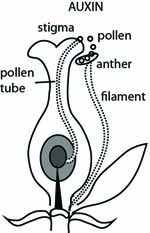
Ingredients: coconut water, barley malt mash, grape juice, grape embryo extract, helichrysum hydrosol, bee pollen, male squash flowers, melissa flower spikes, lavender flower spikes, basil flower spikes.
Researchers say that the enzymes and hormones in pollen are the keys to setting fruit. For this reason, a pollen wort can be fermented with slight adjustments to the standard wort to enhance the fruit set. The shift towards anthesis in a growing plant shoot is governed by auxin as is the immediate next phase of the forming of the pollen tube in the stigma of the ovary (see above).
When the pollen touches the stigma it sends a flurry of phytochemical signals through the plant. The first manifestation of this is that the pollen that is now embedded in the stigma germinates and sends a tube down through the tissues of the stigma in the direction of the embryos in the carpels of the ovary. The inside of the pollen tube is the site of the generation of sperm cells that navigate through the tube towards the virginal embryos.
The ability of the pollen tube to accomplish this is also made possible by auxin. Both the growth of the stamen and the growth of the pollen tube share the tendency of auxin towards the formation of linear structures. Without the pollen tube reaching the embryos, the tendency is for the plant to lack the ability to set fruit. The following wort is used just prior to the opening of the flower buds on plants that are used for fruit production.
Pollen Cap
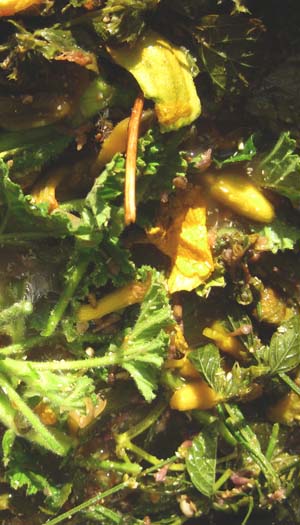
Directions for making a pollen cap:
Take the ingredients of a gallon of standard wort as a base.
Add an additional quart of coconut water and/or aloe gel. This ups the auxin content considerably.
To this mix also add a cup or two of molasses. This adds calcium and magnesium in a good proportion to support the hormonal digestion of the herbs added to the cap to enhance pollen content of the wort.
It is useful to include as many flowers that are in the anther formation stage as possible as a cap for the pollen wort. The flowers of the terpene-rich herbs like lavender, melissa, basil, and helichrysum provide a wide selection of anther-produced pollen.
Bee pollen from the health food store can provide a rich source if flowers are not available but it is the fresh pollen that activates this wort the best.
Fava beans or peas in season produce prolific flowers that can be added to the cap. These have the added dimension of acting in a particularly potent way on anthesis.
Another good addition is the prolific male flowers of cucurbits. The large squash flowers with abundant pollen often just dry up and fall off for weeks before the female flowers show on the vines. These wasted males can be added to great advantage to the cap of the pollen wort and turned under several times a day as the wort works them to the surface.
When this wort stops working, strain it and let it to mellow out in a bucket with a loose-fitting lid so that it gently goes into vinegar ferment. With so little alcohol in the wort the vinegar will not be obsessively acidic but just enough to preserve the vital forces.
Spray for two consecutive days once a week when flower buds appear and continue until fruit is set.
This wort is especially useful when sprayed in the days before flower buds open on perennial fruit trees in spring. It brings a touch of summer pollen warmth into the time of cold rains.
Fruit wort (cytokinin fruit)
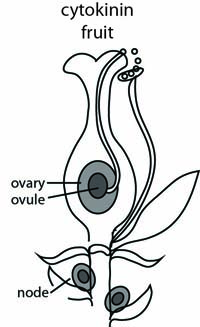
Ingredients: coconut water, grape embryo extract, peach pit extract, grape juice and pomace, apple juice and pomace, calcium citrate extract, helichrysum, melissa, pelargonium.
While fruit set is auxin-regulated by pollen production in the anthers, once the fruit is set the swelling of the fruit requires a steady stream of minerals and sugars. This is regulated by cytokinin. The wort for the fruit swelling veers away from flowers and pollen and into the fruit-producing process itself.
Fruit production is not related to anther formation but to axial bud formation. The carpels of fruits can be linked to the horizontal axial bud stream within the plant. The hydrosols are the standard herbs used to promote cell division in the meristem.
However, the wort itself and the cap are composed of fruit peels, fruit juice, seeds, and stems. Fruit stems like the petioles on leaves are bottlenecks in the flow of nutrients in plants. To ensure ample flow across the stem of a fruit tannins and other phenolics are active. These substances are most plentiful in skins and seeds and stems of fruits.
Fruit Cap
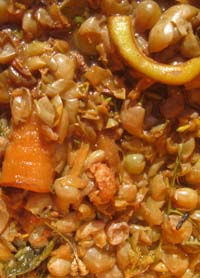
Ingredients: apple skins and cores, grape pomace with seeds, and other plant residues like this are ideal for constructing a fruit wort.
During the late summer when fruit canning is done is a good time to start this fruit wort ferment.
Extracts of embryonic grape and peach pits (peach embryo when in the form of a jelly), as well as grape sap from bleeding vines or sugar maple sap in early spring, are also good additions with their high cytokinin content. These are harvested in the early spring but are added to the ripened fruit residue in the late summer creating a fruit complex in the wort.
A liquid mix of fruit, fruit extracts, and hydrosols is the base. To this can be added barley malt extract. This is a sugar source with little diastatic potential but it is very harmonizing to the other sugars. Molasses with its calcium and magnesium content also adds another sugar source accompanied by minerals vital to plant metabolism. The cap of peels, cores, seeds and stems naturally adds phenolics that support transfer of nutrients across petioles and fruit stems.
Beer wort at its alcohol limit range of 4.5 PA may go dormant quickly before the sugars are resolved in this wort because of the sweetness of the fruit juices. To allow the yeast to complete its metabolic cycle the addition of kelp beer or coconut water as a diluent is serviceable. It is necessary for the yeast to finish the wort since unfinished sugars in the final spray may be the source of mildew on young fruits in the low temperatures of spring.
The finishing of the ferment by the beer wort can be controlled by diluting the sugars with the kelp beer or coconut water. The wort is settled after a complete ferment taken to a mild acid pH. Spray dilution is 3 tbsp per litre for the wort. The addition of 20% skim milk to the wort in the sprayer ensures that the swelling fruits will be supplied with sugars and potassium to grow well and attain optimal sweetness.
Leaf wort
Ingredients: coconut water, blackstrap molasses, dextrose, barley malt extract, helichrysum, Melissa, pelargonium, beer wort.
A simpler wort can be built to digest mineral substances that support vegetative leaf production. Leaf production is pretty much about getting available minerals through the petiole. The flow from below through the xylem needs to be enhanced and maintained. There are several reasons why this would not hhave to do with mineral availability in the plant sap.
One issue is the unavailability of calcium in plant sap. When calcium is available its function is to aid the transport of other metals to growth sites. In this function, it is in a push-pull relationship to magnesium. Magnesium produces the materials needed for growth in photosynthesis and calcium aids in the distribution of those materials such as sugars and other macronutrient metals like potassium.
However calcium tends to move to a growth site and be deposited in the form of cellular constituents as sugars are metabolized. This means that the calcium that was mobile is no longer available for building future cells down the line. This calcium fixing tendency can have a grave effect on meristematic tissues. What is needed is that calcium be made available in a constant flow from below. That is the function of the xylem that feeds the leaf through the petiole.
To enable calcium to flow through the petiole a supply of sulfur is necessary. The sulfur keeps the calcium mobile in the saps moving through the plant in the xylem. There is a special substance that unites calcium, magnesium, sugar and sulfur. That is blackstrap molasses. The basis of a fine leaf wort is a mixture of coconut water and molasses. The goal is to provide leaf growth with a constant source or hormones, enzymes and minerals. For that reason, this wort is best made in the early spring when sources of cytokinin are readily available that don’t have the finely formative gestures of grains.
The gesture of grains is to move past leaf formation in the production of seeds. What is needed by leaf formation is a robust vegetative gesture. This is provided by grape sap before vegetative bud break, embryonic peach or plum fruits, or embryonic grapes crushed and steeped in water for a few days. The steeping is to extract the cytokinin.
This extract is then mixed with the molasses and coconut water to form a good base for a leaf wort ferment. Hydrosols of melissa leaves or pelargonium leaves taken before any flowers emerge can also provide herbage for a cap for the wort. The ferment should be allowed to move into a slight vinegar form. If done well this wort is stable and can be kept in a cool dark place in dark bottles for later use in the fall as an amendment to manure or compost teas for crops like lettuce and cabbage.
Spraying the emerging seedlings twice weekly until a leaf rosette appears is best for this cytokinin spray. From then on the leaf wort added to compost tea, or added to rainwater with additions of kelp beer, fish emulsion or skim milk for root feeding, puts cytokinin in the xylem flow.
However, cabbage and head lettuce are actually flower buds. A bit of auxin from the pollen wort sprayed on the growing tip at the heading stage turns the leaf gesture inward while it is fed from the root with cytokinin. In this way, auxin and cytokinin collaborate in producing remarkable heads of cabbage.
Technically, in early growth stages due to the cytokinin influence it is sometimes necessary to remove axial buds shooting from the stalk until a true head begins to form. Once heading begins the pollen wort acts on the head and axial bud development diminishes. On the other hand, too much pollen wort at heading and the head will tend to bolt. Once again the great rule is all things in moderation.
Classic terpene wort
At the end of the summer, many medicinal plants go into a terminal flowering process. At that time the essential oils in many of them have gone from soft to hard due to the increase of caustic oils like camphor in the heat of late summer. To extract essential oils at this time from plants can yield a harder more resinous fragrance. However, taking advantage of the increase of essential oils in plants like lemon balm, basil, marjoram, pelargonium, and lavender extraction of hydrosols at this time can contribute to the production of superior ferments for next season’s spray program.
This is especially the case for the formation of terpene spray since the abundance of oils will be digested well by a gentle ferment at this time with the added advantage of a mellowing phase throughout the winter. The cooler temperatures and extended mellowing will move the ferment into a gentle malolactic or vinegar condition without volatizing the terpenes in the mix. A final addition to this will be the formation of salts made from the herbs to create a spagyric solution.
Directions for creating a spagyric wort:
Start with two gallons of hydrosol made from the herbs.
To that add a gallon of solution made from barley malt. This is used to create the most gentle ferment.
Mash one pound of barley malt berries by grinding or cracking them into a medium / medium-fine grind in a mill.
Pour on a gallon of water at 50°C / 105°F. Let this soak for several hours.
After this soak bring the mash to 65°C / 125°F. Keep the temperature there for a few more hours. Don’t go over this temperature or you will destroy the diastatic action of the malt in the wort.
Strain the liquid and add it to the hydrosols and two quartz of coconut water.
Dissolve one cup of blackstrap molasses, one cup of honey and one cup of barley malt extract in the warm mixture.
Test for 4.5 potential alcohol. If too low add more molasses or barley malt extract.
Put the mix in a five-gallon bucket. Put the herbs from the still on top of the warm sweet wort and let it settle into a cap.
When the temperature drops to room temperature sprinkle the beer yeast on the cap and let it accommodate to the mash.
When it has proliferated, stir it in, cover with a cloth and let it ferment for a few days until the cap begins to sink.
Strain the liquid into gallon jugs or another bucket with a lid.
Take the herbs that have been fermented and dry them. Calcine them over a charcoal fire in a pot with a small opening. They will gradually turn from a black charcoal into a white ash.
Soak the white ash in rain or spring water to draw out the salts.
Evaporate the salt water and collect the salts.
Very small amounts of the pure salts can be added to the wort as it slowly goes malolactic. These salts complete the spagyric profile of the wort.
Let this sit through the winter and use as a spray in the spring when medicinal plants begin to form their first leaves. There may be a bacterial mother on the wort in the spring. That means the wort did a complete cycle.
Experimental results
The following results were observed in the 2017 growing year. My protocols are based on spraying the plants on one side of a garden bed with unsprayed plants on the other side of the same bed as control. On trees or bushes, spraying only one half of an herb bush or fruit tree allows the other half of the tree that remains unsprayed as a control.
The images at the beginning of this article of the basil stalks revealed the action of cytokinin rich terpene spray on the seedlings from the sixth leaf until the commencement of flowering. The terpene spray enhances the axial buds enabling them to shoot early from the original shoot. At term, this increases the production of inflorescences on an individual plant. This in turn increases the formation of the anthers that guide the shifts in the phytochemistry of the plants and moves it towards terpene (medicinal and culinary) substances.
Mexican marigold (tagetes lucida) sprayed early in the spring produced abundant flowers in the fall on multiple shoots on the sprayed side while the control side had fewer flowers on shoots that produced little side development.
On a mature navel orange tree the spray to control ratio for fruit set into maturity was slightly less than 3:1. Nine oranges came to harvest on the control side of a mature navel orange and twenty-five oranges came to harvest on the sprayed side. The difference was due to the failure of flowers to produce fruit set on the control side as well as the tendency for the fruit to split during the commencement of ripening. The sprayed oranges set fruit readily with very little loss in splitting.
A mature pomegranate bush produced a similar pattern between the control side and the spray side. Twenty-nine pomegranates came to harvest on the spray side with eleven pomegranates coming to harvest on the control side of the bush. Splitting of the fruit on the control side was also evident with no splitting on the spray side.

Dennis Klocek
Dennis Klocek, MFA, is co-founder of the Coros Institute, an internationally renowned lecturer, and teacher. He is the author of nine books, including the newly released Colors of the Soul; Esoteric Physiology and also Sacred Agriculture: The Alchemy of Biodynamics. He regularly shares his alchemical, spiritual, and scientific insights at soilsoulandspirit.com.
Similar Writings
Thoughts on the BioDynamic Preparations
For even the most ardent supporters of Biodynamic agriculture understanding the BD preps is challenging. For instance, it is difficult for a business owner to explain to a client why cow manure put in a cow horn is a soil amendment. That is one side. On the other side, practitioners themselves express difficulty seeing the…
